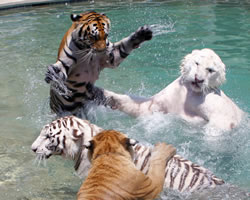GENETIC DIVERSITY OF TIGERS AND MANAGING CAPTIVE POPULATIONS
Unfortunately saving tigers has greatly become a function of politics. If you can help conserve our natural resources, I urge you to do so. If you cannot help, please don't make it more difficult for the people who are helping
-Robert Johnson
President, International Wildife Conservation and Education Coalition
-
What’s in a Color
Importance of Preserving Genetic Diversity and Rare Variants of Tigers

It is very important to preserve genetic diversity because of its great value. Changes within populations that occur as a result of adaptation are what lead to new species and also expansion of species into new environments. Adaptation only works on the variation that is present within populations and species. Mutation rates are in general too slow to generate beneficial mutations in response to stress or change in the environment. Therefore, the variation that is present within a species largely affects its ability to adapt to a changing environment. In addition, in most species variation has a positive effect on fitness. In all populations, rare genetic variants are present, these at first are not common, but when conditions change so that the rare variants are advantageous, natural selection works to make these more frequent. If they become fixed, these variants can positively change the characteristic of a species.
-
Species Change Through Time

The effects of genetic variants can change as they interact with other genes and the environment. Species are constantly changing, how we see them today is not how they looked when they diverged from their ancestor, and it will not be how they look as they continue to adapt. Polar bears are a good example. This species evolved from grizzly bears, and therefore its ancestor was likely brown or black in color. There was a mutation in this ancestor that changed its coat to white. Although this white coat color is not adaptive in most of the regions where grizzly bears occur, it is very beneficial in the arctic, where polar bears currently live. We do not know if the polar bear gained its white coat color before or after it shifted its range to the arctic, but we do know that today this color is very advantageous in its environment.
-
Genetic Variation Increases Potential to Adapt
As we cannot foresee what regions species will expand into or what environmental changes will occur, we should manage species to preserve their genetic variation so that they maintain their potential to adapt. This includes protecting rare variants such as white tigers and tabby (brown) tigers. We cannot predict whether in 100,000 years, or even only 10,000 years, either of these coat colors will become adaptive for tigers. What is certain is that if the white color is bred out of tigers, the tigers potential to adapt to future changing conditions will be reduced. In addition, we do not know future changes that will naturally occur through mutations to the white coat color. Coat colors are modified by multiple genes in a complex way, it is conceivable that with an additional mutation, the coat color of the white color could be modified to become grey, and then this color would be very similar to that of the snow leopard, making it adaptive in the higher latitudes on the edge of the tiger’s range in Nepal, India, and Bhutan.
-
Problems for Small Populations – Inbreeding and Genetic Drift
If a population is significantly reduced in size, there are fewer individuals that can potentially be bred to each other. For this reason small population size leads to inbreeding, or the mating of two closely related individuals. If the potential breeding tiger population in the United States was reduced to only the tigers owned by AZA zoos, it would become more common for related individuals to mate with one another. Over time, this would result in a higher number of inbred individuals. Inbreeding increases the likelihood of both parents sharing the same disorder; leading to higher frequency of rare genetic diseases and deformities in the small population. This is portrayed in the frequency of genetic disorders in many dog breeds that have recently been inbred, for example hip dysplasia in Labradors and epilepsy in Golden Retrievers.
-
Inbreeding and Genetic Diseases
One of the other benefits of genetic variation is its impact on heritable and infectious diseases. There are some rare genetic variants that are bad for the animal and they cause heritable genetic diseases. Rare variants that lead to disease are often recessive and not common, meaning that the individual must inherit the same variant from both parents for the disease to be manifested. In large populations, the chance of two parents having the same rare disorder is low; therefore the frequency of the specific rare disease is also low. A good example is hip dysplasia in Labradors that occur more often after inbreeding.
-
Inbreeding and Disease Resistance

Inbreeding also makes small populations more susceptible to infectious diseases. Genetics play an important role in an animal’s ability to fight off disease. In many populations, having a single genetic variant may determine if the animal can recover from an devastating new disease. As inbreeding and small population size decrease the overall genetic variation, important but sometimes rare alleles (different variations of a gene) are often lost. When this happens, the whole population is at risk of extinction when a new disease is introduced to the population. One good example of this is the endangered black-footed ferret. After many years of successful recovery efforts to reintroduce the black-footed ferret from zoos, the population was wiped out by parvo virus and the bubonic plague because of the low genetic diversity of the population.
In addition to the loss of important alleles that confer disease resistance, genetic variation of MHC and Toll-like receptors affect the ability of individuals to recognize pathogens and therefore also resist diseases. In small populations, genetic variants at these genes are lost and therefore they often become more susceptible to diseases because the immune system can no longer recognize the pathogen. It is therefore important to maintain genetic diversity at these MHC genes as well. In large populations, high levels of genetic variation for genes that influence pathogen recognition and pathways that fight pathogens are important for maintaining resistance to diseases, and reducing the number of animals that become sick. -
Genetic Drift
Populations that are of small size with small number of breeders lose genetic variation through a process called genetic drift. Genetic drift is the random loss of alleles from a population due solely to chance. Genetic drift is a natural process that occurs in all populations. In small populations, however, genetic drift happens very quickly. The genetic drift is rapid, important alleles can be quickly lost from the population.
In addition, because of inbreeding also found in small populations, rare diseases variants can become fixed and occur more often. These processes work together to reduce fitness of individuals and the overall population health, and greatly increase extinction risk. This increased extinction risk of small populations has been found in nearly all species studied, including Florida panthers, snakes, butterflies, wolf spiders, prairie chickens, and domestic animals such as dogs, cats, and horses. -
Value of Outbreeding, the Florida Panther Example
There is a great value to outbreeding populations. In populations that have undergone a major recent bottleneck (a major reduction in numbers of individuals) and have few breeders the introduction of new breeding animals immediately increases fitness in the subsequent generations. This can lead to population recovery. The fitness parameters that have been found to improve after outbreeding include sperm quality, lower frequency of genetic disorders such as heart problems, number of offspring, disease resistance, and juvenile survival. A great example is the Florida panther. In the 1980s, this species was declining rapidly, but after the release of 8 Texas female cougars the population rapidly started to recover. Today, nearly all of the Florida panthers are offspring of Texas /Florida crosses and have much higher fitness than they did in the 1980s.
Do not cut down the forest with its tigers, and do not banish the tigers from the forest. The tiger perishes without the forest, and the forest perishes without its tigers.
-From the Sanskrit epic, Mahabharata
